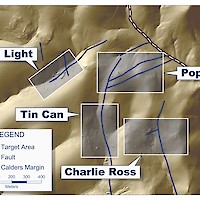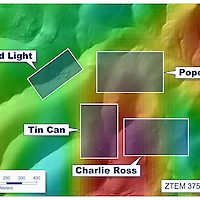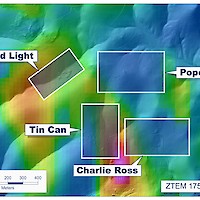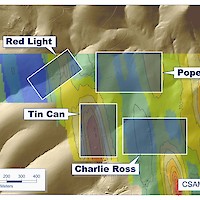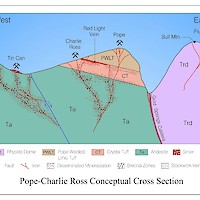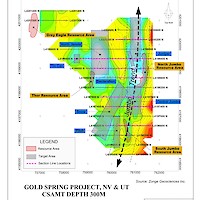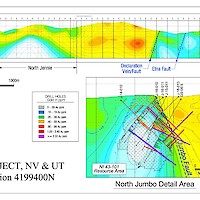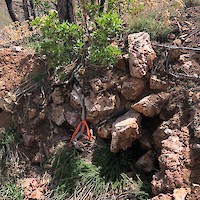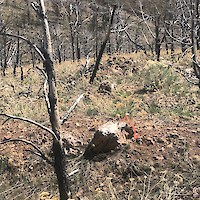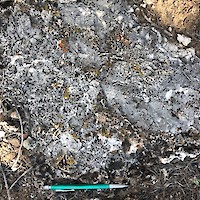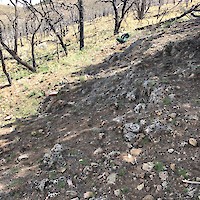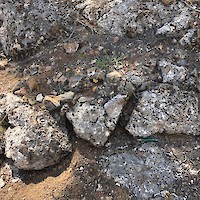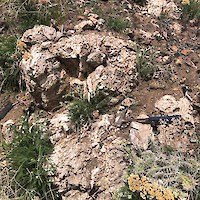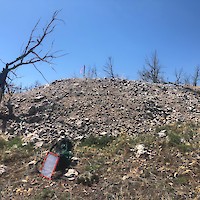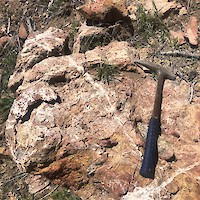System Type:
High-grade, banded, epithermal, quartz veining, breccia and stockwork zones.Tin Can displays a carbonate sinter suggesting a very high-level exposure of the gold system.
Strike-Length:
Tin Can has an exposed strike length of 500 metres before going under post mineral cover. CSAMT geophysics suggests a potential strike length of 1 km. The vein and alteration zone has an exposed width of 200 metres before going under cover.
Resource:
None at this time
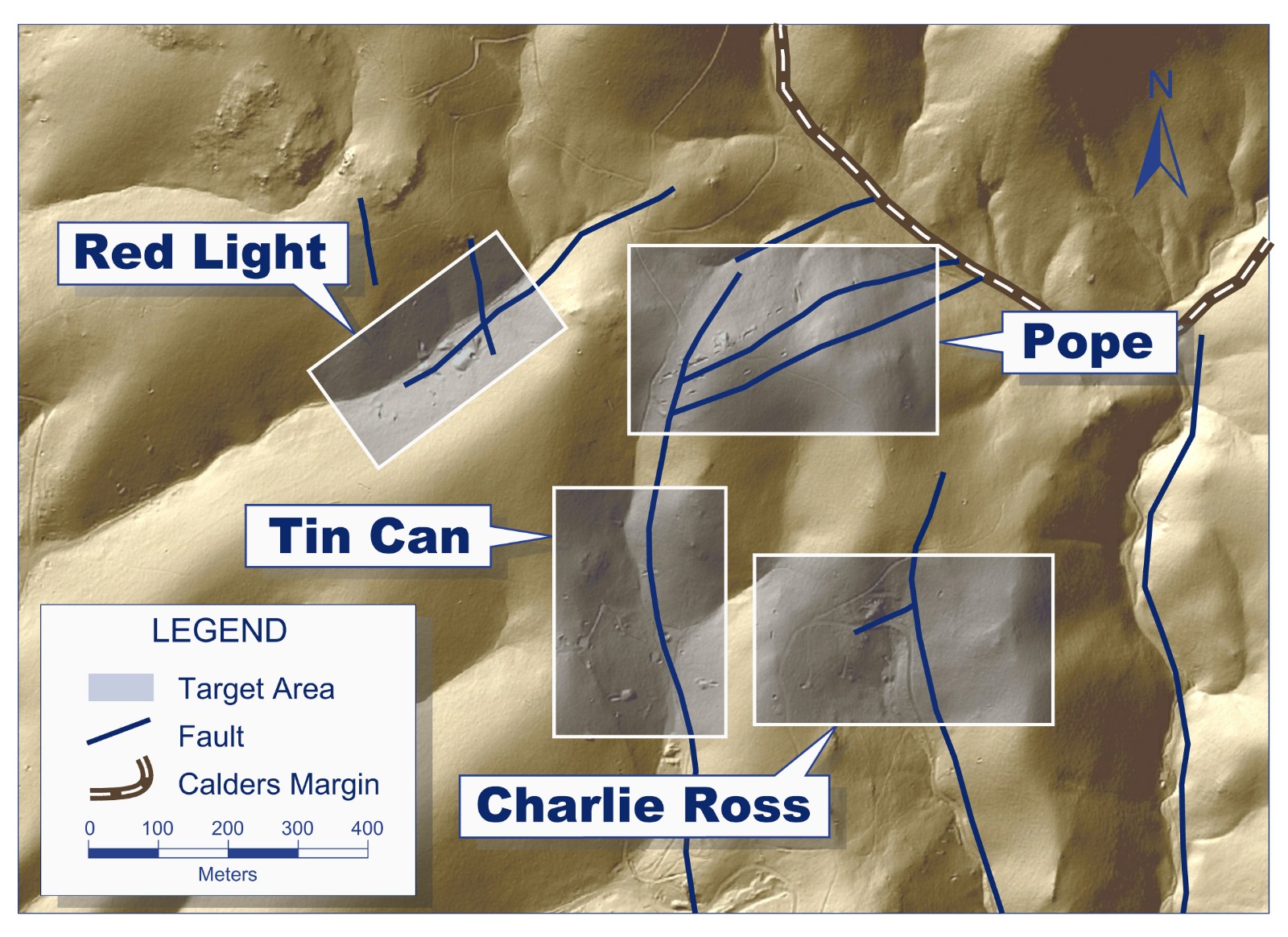
Location:
The Tin Can target is located on the Nevada side of the Gold Springs project area, situated immediately north of the historic Little Buck mine and 350 metres west of the Charlie Ross target.
Drilling:
Three RC drill holes were completed at the Tin Can target in 2012. Holes TC-12-001 and 003 were drilled from east to west testing the main structural zone and the CSAMT anomaly, and hole TC-12-002 was drilled to the northeast targeting an intersecting strcuture. Hole TC-12-001 averaged 0.38 g/t Au and 7.7 g/t Ag over 19.8 metres starting at 88.4 metres and 0.9 g/t Au with 8.9 g/t Ag over 6.1 metres starting at 137.2 metres. Hole TC-12-002 was drilled in an easterly direction to test a northeast trending structural zone consisting of quartz veins and stockworks, and the hole was lost in a void thought to be a solution cavity but could also be historical underground workings. Gold values were increasing in the drill hole prior to it entering the void, with an interval of 12.2 metres (141.7 to 153.9 metres) averaging 0.35 g/t gold, and where silver values averaged 15.9 g/t over the bottom 3.05 metres (150.85 to 153.9 metres). Abundant calcite veining was observed in these intervals. Hole TC-12-003 intersected only scattered 1.5 metre intervals between 0.25 and 0.9 g/t Au.
Geophysics:
The gold mineralization at Tin Can is associated with a strong north-south structural zone which also controls the mineralization a thte historic Little Buck Mine and is highlighted by strong north-south trending ZTEM and CSAMT geophysical resistivity anomalies (See Map below).
Geology:
This area is characterized by a wide area of strong sericitic and silica altered andesite with multiple north striking banded quartz-calcite veins. There are many historical pits and tunnels which exploited the gold barring veins. Outcrops of what appears to be a carbonate sinter signifying a preserved paleosurface and high-level expression of an epithermal gold system are located on the northern end of this target. The area is dominated by a north-south trending structural zone which hosts the veins and is at the projected structural intersection with a northeast trending structural zone. The eastern portion of the trarget is covered with a post-mineral tuff and the western portion is covered by a post-mineral colluvium. The CSAMT ground geophysical survey shows this target to be underlain by a resistivity anomaly of similar magnitude to that seen at the North Jumbo resource.
Structural Geology:
The target consists of a series of parallel structures oriented generally north-south which are extensions of those controlling mineralization at the historic Little Buck mine. This structural zone can be traced for 500 metres on surface before going under post mineral cover and has an exposed width of 200 metres.
Historical Mining:
The Tin Can target has numerous pits and one larger adit exploiting the mineralized veins.
Geochemistry:
Historic mining in the area was focused on a banded quartz-calcite vein up to 2 metres wide that grade up to 5.20 g/t gold and 61.5 g/t silver. This quartz-calcite vein is margined by zones of silicified breccias and stockwork veining that grade as high as 1.19 g/t gold and 46.2 g/t silver. A total of 49 rock-chip samples were collected from the Tin Can target with 14 samples returning values above the resource cut-off grade.
Table: Rock Chip Sampling Results from Tin Can:
|
Sample |
Sample Type |
Target |
Description |
Au g/t |
Ag g/t |
| 224382 |
Float |
Tin Can |
Brecciated silicified lithic crystal tuff with stockwork veining |
0.28 | 4.7 |
| 224386 |
Outcrop |
Tin Can | Brecciated silicified andesite with drewsy/chalcedony quartz cement | 1.19 | 46.2 |
| 224387 | Outcrop | Tin Can | Banded/bladed quartz-calcite vein with green chalcedony quartz bands | 5.20 | 61.5 |
| 224388 | Dump | Tin Can | Banded/bladed quartz-calcite vein | 4.10 | 35.3 |
| 224389 | Float | Tin Can | Banded/bladed vuggy white quartz vein | 0.27 | <0.5 |
| 224390 | Outcrop | Tin Can | Banded, vuggy white quartz vein | 0.42 | 26.2 |
| 224391 | Dump | Tin Can | Quartz-calcite vein | 0.38 | 16.6 |
| 224393 | Float | Tin Can | Banded/bladed white quartz vein | 0.69 | <0.5 |
| 224437 | Outcrop | Tin Can | Sericite altered andesite with quartz stockwork veining | 0.31 | <0.5 |
| 224439 |
Dump |
Tin Can | Quartz-calcite vein | 0.6 | 7.2 |
| 224441 | Dump | Tin Can | Quartz-calcite vein | 2.74 | 37.8 |
| 224442 | Outcrop | Tin Can | Bladed quartz-calcite vein | 0.76 | 18.4 |
| 224448 | Dump | Tin Can | Hydrothermal breccia | 0.46 | 26.2 |
| 224449 | Dump | Tin Can | Quartz-calcite vein | 3.27 | 60.7 |
A cutoff grade of 0.25 g/t Au was used, which is the cutoff grade of Gold Springs’ existing resources.

